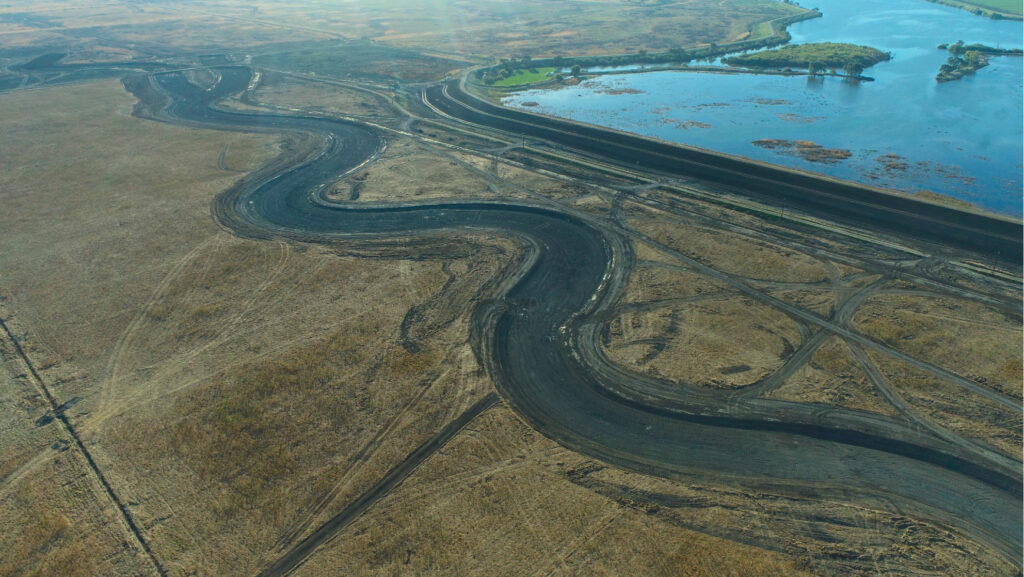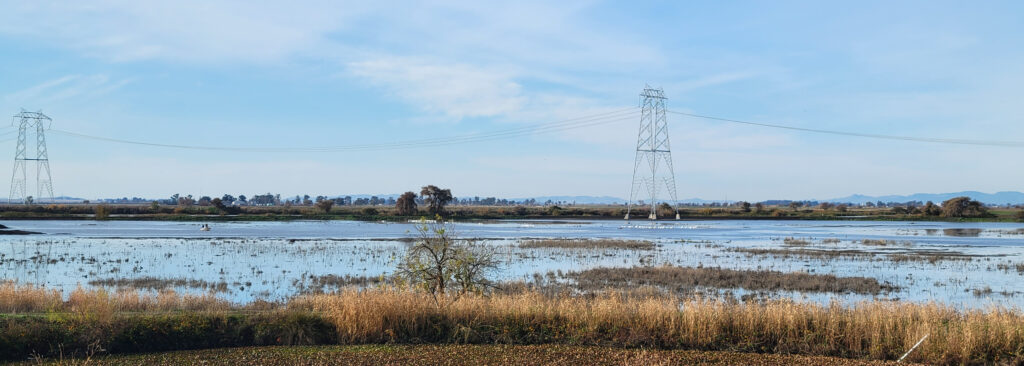
When the restoration of Lookout Slough is complete, Lookout Slough will be no more. Created to provide water for a century-old duck-hunting club, the human-made canal will be filled in as part of a $119 million, 3,400-acre tidal wetlands restoration, the largest ever in the Sacramento-San Joaquin Delta.
“Drought and climate change have elevated the importance of these types of multi-benefit projects,” said Karla Nemeth, director of the California Department of Water Resources, when the project broke ground last June. “This project will reduce flood risk for communities in the Central Valley and create much-needed habitat for Delta smelt and other endangered and threatened fish species.”
By their expected completion in late 2024, the new tidal wetlands will replace former irrigated pasture and duck-hunting clubs in eastern Solano County at the lower end of the Yolo Bypass. In addition to creating shallow-water aquatic habitat, the transformed area will provide 40,000 acre-feet of water storage to help prevent flooding and protect surrounding communities.
“The current science is that between 60,000 and 80,000 acres of habitat need to be restored in the Delta,” says Charlotte Biggs, project manager for the Department of Water Resources.
Lookout Slough is adjacent to two completed tidal wetlands restorations, Lower Yolo Ranch and Yolo Flyway Farms, which are about 2,000 acres combined, as well as Liberty Island, which provides open-water and shallow habitat, Biggs says. It is also a critical piece of 16,000 contiguous acres of restored wetlands planned for the Cache Slough region. “Restoration has more of an impact at the landscape scale,” Biggs says. “The larger these restored areas are and the more connected they are, the more benefits they will provide.”

The Lookout Slough restoration site is bordered by Liberty Island Road to the north; Shag Slough to the east; and Duck, Hass, and Cache sloughs to the west. Ecosystem Investment Partners (EIP), a national private-equity environmental restoration firm, has managed all of the project’s planning, design, permitting (by nine state and federal agencies), and now, construction. When the restoration work is complete, EIP will “hand over the keys” to the Department of Water Resources for long-term management.
In February, construction of the new marsh was well underway, albeit somewhat slowed by winter rains. Leading a tour of the huge construction site, EIP project manager Stephanie Freed pointed out the 60-acre portion of the property, known as Vogel Island, that was restored to tidal flow by breaching 1920s-era agricultural berms adjacent to Cache and Hass sloughs this past October. “It’s functioning just as we designed it to,” she said.
The existing levees around the larger Lookout Slough property continue to restrict tidal waters from the remaining 3,100 acres until a 25-foot-high setback levee can be completed at Duck Slough. Then, a network of more than 20 miles of new channels will be constructed within the property, followed by the breaching of Shag Slough in nine places to allow in the natural flow of the tides.
The Department of Water Resources will receive credit for about 3,000 acres of restored habitat for the endangered Delta smelt, partially fulfilling the agency’s obligation to create 8,000 acres following a 2008 Biological Opinion issued by the U.S. Fish and Wildlife Service. The new aquatic habitat is also consistent with the 2009 Biological Opinion issued by the National Marine Fisheries Service regarding operations of California’s State Water Project and federal Central Valley Project.

In addition to Delta smelt, the project is expected to support longfin smelt, Chinook salmon, green sturgeon, steelhead, numerous birds, and the threatened giant garter snake, a five-foot-long snake found only in about a dozen isolated marshy areas of the Central Valley. “The EIP project team actually discovered that the giant garter snake was here,” says Bill Arnerich, lead biologist for the project. He identified five giant garter snakes and relocated three outside of the work area unharmed during the first year of construction. In addition, throughout construction the project is maintaining a 54-acre relocation area that “has all the habitat elements that the snake needs,” Arnerich says.
When complete, 75% of the Lookout Slough wetlands will be intertidal habitat and 17% subtidal habitat; the rest will be upland areas including levees, access roads for PG&E transmission towers, and islands where birds can roost and nest.

While numerous marsh-dependent species will undoubtedly benefit from the new habitat, the jury is still out on whether any amount of new tidal wetlands can bring back the Delta smelt. John Durand, senior research scientist with the UC Davis Center for Watershed Sciences and a board member of the area’s Reclamation District 2098, applauds the transformation of “a huge swath of low-value rangelands” into aquatic habitat. However, he is concerned that invasions of aquatic weeds will clog up tidal waterways and obstruct native fishes such as the Delta smelt, which is, he says, functionally extinct. “One restoration project is not going to be able to save the smelt.”
State and federal agencies are not giving up on the Delta smelt. “We’re very aware of this issue of invasive weeds and how they threaten the functionality of the shallow-water habitat ecosystem,” says Louise Conrad, Department of Water Resources lead scientist. The agency has an agreement with the California Department of Fish and Wildlife to monitor and study invasive species and their impact on the aquatic food web, plus a $30 million partnership with the California State Parks Division of Boating and Waterways to treat invasive aquatic vegetation in restored delta wetlands, including with nonherbicidal treatments such as mowing and burning, Conrad says.
For the past year, UC Davis fish scientists have released thousands of hatchery-raised Delta smelt near Rio Vista and tracked their movements in an effort to figure out if and how the finger-size fish can be brought back from the brink of extinction. “Lookout Slough is not a silver bullet for restoring Delta smelt,” Conrad says. “We’re trying to stand in the way of complete extinction and reverse its population trajectory to one that is positive.”
Regardless of how the Delta smelt fares, Biggs says that a restored Lookout Slough will provide a multitude of benefits for aquatic ecosystems, people, and the Delta. “This project provides benefits to the whole food web, not only for Delta smelt but also larger fish, birds, and wildlife that benefit from having more food sources in the Delta.”
Top Photo: Vogel Island after breaching during first filling. Photo: EIP/Bill Arnerich
Groundbreaking Celebrates California’s Largest Tidal Habitat Restoration Project